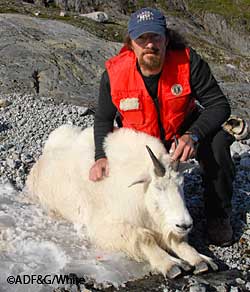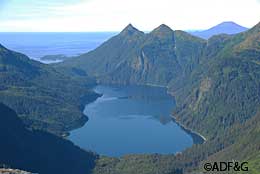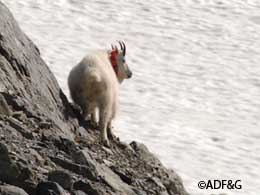Alaska Fish & Wildlife News
November 2010
Mountain Goats: Mysteries and Management

Mountain goats have a great appeal for hunters and wildlife watchers, but for biologists, they also represent a living link to the ice age.
State wildlife biologists and their collaborators are discovering valuable insights into how mountain goats use their habitat in summer and winter, their kidding and nursery areas, and how different populations are related. The research is also raising questions about where goats found refuge during the glacial maximum and how they dispersed when the ice age glaciers retreated.
Last summer, Alaska Fish and Game biologists Phil Mooney, Jeff Jemison and Kevin White captured 12 mountain goats on Baranof Island and equipped them with GPS tracking collars, primarily to study the potential effects of expanding the Blue Lake hydroelectric project near Sitka. The hydro project, which involves adding a new turbine to increase electrical generation capacity by 33 percent, will raise the level of the lake 80 feet, and part of the area that will be inundated is goat winter range. The project provided funding for Fish and Game to join the U.S. Forest Service and the city of Sitka for the equipment, drugs, helicopter flights and staff time needed for the work.
Biologists plan to capture and tag another 12 goats next year to study potential impacts of a hydro project on Takatz Lake on the east side of Baranof Island.
White has captured more than 200 mountain goats in recent years in Berners Bay, northern Lynn Canal, the Haines/Skagway area and on the Cleveland Peninsula near Ketchikan. Each project has specific goals, but contributes knowledge to our overall understanding of this unique animal.
The goats in the Blue Lake area are important to Sitkans.
“The population is right here, very close to town,” said Mooney, the Sitka area biologist. The goats are popular with hunters, who trailer boats up to Blue Lake, spot goats on the ridges from the road, then cross the reservoir and climb the ridges to hunt. Hunters have taken as many as 70 goats in a season in past years, but the harvest is currently capped at 56 billies or 28 nannies – and Mooney has concerns about that many females being taken.
“We have a point system for total harvest, and nannies count as two, billies as one,” Mooney said. “But even that was too high, so we have a cap of 18 nannies. Our nanny harvest has been about 40 percent. Sitka has had a big effort to educate hunters on nannies and billies.”
Harvesting too many females can have a significant negative impact on the productivity of the population. Wildlife managers can regulate the harvest, but not the immigration of goats from other areas, and that’s something Mooney wants to learn more about.
“We’re real interested in how far goats move around on the island, their winter range, and when hunters take nannies, where are replacements coming from,” Mooney said.
The collared goats should provide those insights. The collars are equipped with both GPS receivers and VHF transmitters. The VHF allows biologists to locate the animals, and the GPS units record the animals’ location once every six hours. New battery technology gives the GPS units a four-year life, and the VHF units a six-year life.

“Some are downloadable, so Kevin can fly over with his laptop and download the data directly, Mooney said. “The data collars have a timing mechanism so they self release and fall off and we can collect them and download, and then refurbish them.”
When the goats were captured, tagged and collared, samples were also taken for DNA analysis. Biologists are investigating some mysteries about the origins of the Baranof Island goats.
In 1923, 18 goats from Tracy Arm were transplanted to Baranof Island. “They also tried a transplant on Chichagof Island (in the 1950s), but that failed,” Mooney said.
About 1,300 goats now inhabit Baranof Island, the descendants of those original 18...or perhaps, also, some more distant ancestors.
“We don’t know of any native populations, but recent DNA work implies there could be some relic population here, and some researchers are really fascinated by this,” Mooney said.
One of those is Aaron Shafer, a PhD candidate at the University of Alberta. He’s studying the evolutionary history and population structure of mountain goats, and said that northern Southeast Alaska is a hotspot of genetic diversity. Alaska’s goat populations are highly differentiated, each with a unique genetic make-up. Shafer has been working with state biologist Kevin White to learn more about these different populations.
“Southeast Alaska goats are made up of a variety of populations separated by geographic barriers,” White said. “For some species, mountains are barriers, but for goats, mountain ridges are routes, and valley floors tend to be barriers. Goats are reluctant to cross valleys.”
That’s understandable, as mountain goats’ key defense against predators is their ability to navigate terrain too steep for bears and wolves.
Shafer has identified genetically distinct populations in northern Southeast; one in the Haines area, another across Lynn Canal north of the Katzehin River near Skagway, another between the Katzehin and Berners Bay, and a fourth inhabiting the area between Berners Bay and the Taku River. Recent data suggest that the Baranof Island goats are yet another unique population – different from the transplanted goats. Data implies these goats were on Baranof before the translocation in 1923, and are likely descended from a population that survived the last glacial period on the island.
Different kinds of DNA analysis provide clues into the evolutionary history of mountain goats in Southeast Alaska. Some analyses indicate relatedness between populations, while others help identify individuals. Some look at mitochondrial DNA passed down by mothers, and others at genes linked to the Y chromosome passed down by fathers.
White has found goats living on nunataks on the Juneau Ice field near the Meade Glacier, isolated peaks that are like islands surrounded by ice. Areas like these likely existed during the height of the ice age, pockets of habitat known as refugia. Biologists and geologists have recognized ice free coastal areas in Southeast Alaska that appear to have served as refugia, from which animals later dispersed.

It appears that during the glacial maximum, two refugia existed for the ancestors of Southeast Alaska’s goats, one to the north and one to the south. As glaciers retreated and goats started colonizing newly exposed habitats, goats descended from these two source populations eventually met in the northern B.C. coast, with some mixing occurring as far north as the Stikine River area. Goats in the Haines area descended from animals that survived the ice age on the northern refugia; goats from southern Southeast descended from goats that survived on the southern refugia; and goats from the Tracy Arm and Stikine River area have a mix.
Some of the Baranof Island goats seem to have descended from goats with this mix – these would be descendents of the transplants. But most of the goats sampled from Baranof had DNA consistent with the southern lineage, implying that there was an unknown population of goats on Baranof Island back in the 1920s – before the time of the transplant, animals whose ancestors had colonized Baranof from the south as the glaciers retreated.
Shafer found another odd twist. Some of the Haines goats share a unique form of a gene with the Baranof goats, one passed on by males.
“The most plausible scenario is a couple billies from Baranof dispersed up to Haines, and their genes passed into the gene pool in Haines,” White said.
There are cases documented of long distance dispersal. Shafer found that in samples from more than 800 goats in North America, there were 17 cases of long distance dispersal – for example, goats from the Canadian Rockies having DNA profiles of animals in coastal British Columbia. The Oregon Department of Fish and Wildlife documented a collared goat from Northeast Oregon’s Wallowa Mountains crossing the Columbia River and moving to the Central Washington Cascade Mountains.
Despite their reluctance to cross open valleys, it’s clear that some goats will travel. That adventurous spirit on the part of some individuals was key to the dispersal of this species as the ice age waned and new habitat opened for colonization in Alaska.
Riley Woodford is a writer with the Division of Wildlife Conservation and edits Alaska Fish and Wildlife News.
For more on mountain goat identification, see: http://www.adfg.alaska.gov/index.cfm?adfg=quiz.overview&quiz_id=3
For more on mountain goat hunting, see: http://www.adfg.alaska.gov/index.cfm?adfg=goathunting.resources
For more on mountain goats in general, see:
http://www.adfg.alaska.gov/index.cfm?adfg=goat.main
Subscribe to be notified about new issues
Receive a monthly notice about new issues and articles.
